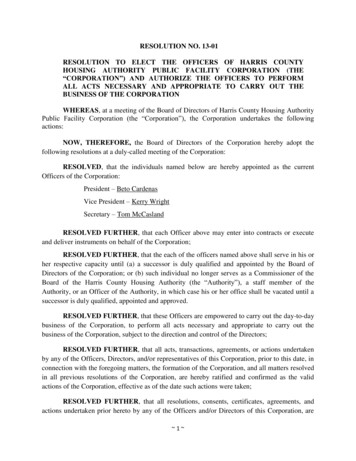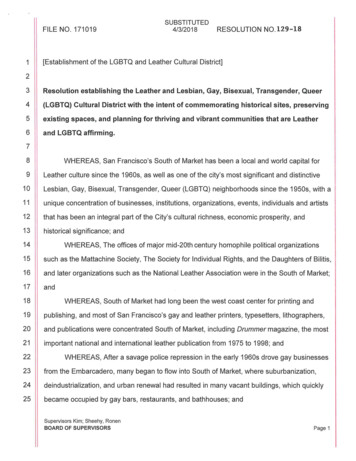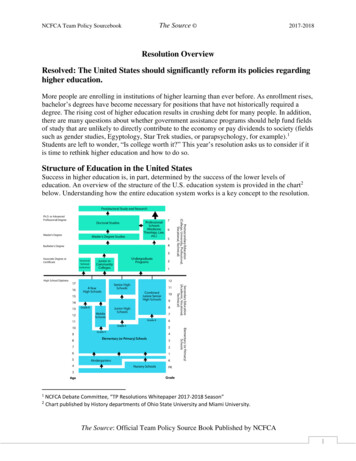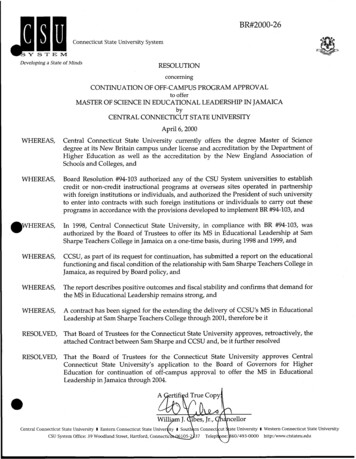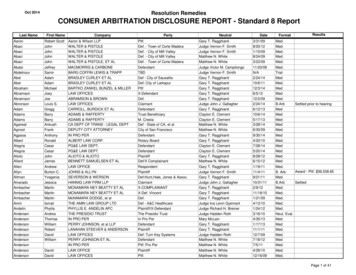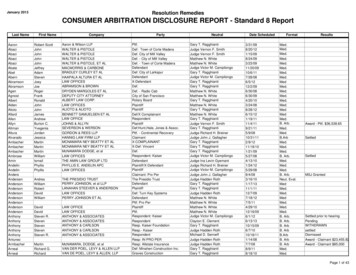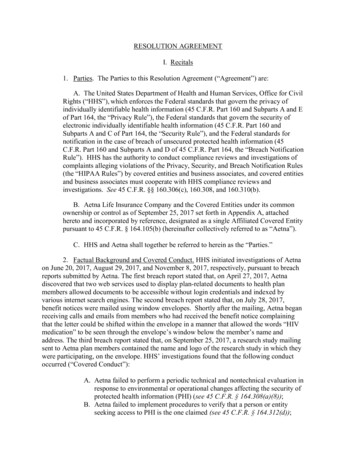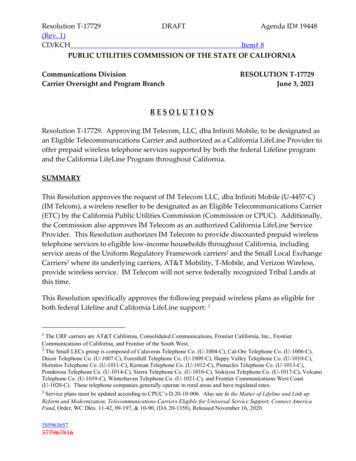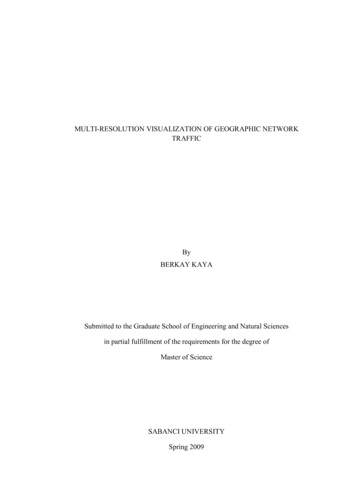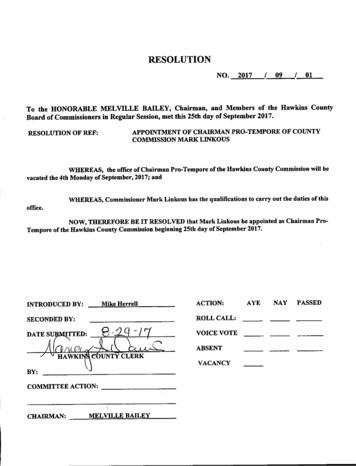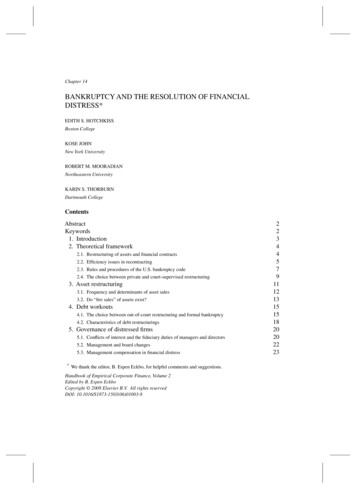
Transcription
Chapter 14BANKRUPTCY AND THE RESOLUTION OF FINANCIALDISTRESS*EDITH S. HOTCHKISSBoston CollegeKOSE JOHNNew York UniversityROBERT M. MOORADIANNortheastern UniversityKARIN S. THORBURNDartmouth CollegeContentsAbstractKeywords1. Introduction2. Theoretical framework2.1. Restructuring of assets and financial contracts2.2. Efficiency issues in recontracting2.3. Rules and procedures of the U.S. bankruptcy code2.4. The choice between private and court-supervised restructuring3. Asset restructuring3.1. Frequency and determinants of asset sales3.2. Do “fire sales” of assets exist?4. Debt workouts4.1. The choice between out-of-court restructuring and formal bankruptcy4.2. Characteristics of debt restructurings5. Governance of distressed firms5.1. Conflicts of interest and the fiduciary duties of managers and directors5.2. Management and board changes5.3. Management compensation in financial distress* We thank the editor, B. Espen Eckbo, for helpful comments and suggestions.Handbook of Empirical Corporate Finance, Volume 2Edited by B. Espen EckboCopyright 2008 Elsevier B.V. All rights reservedDOI: 0202223
2E.S. Hotchkiss et al.5.4. Changes in ownership and control6. Bankruptcy costs6.1. Direct costs6.2. Indirect costs7. The success of chapter 11 reorganization7.1. Outcomes of chapter 11 filings7.2. Post-bankruptcy performance8. International evidence8.1. The United Kingdom: receivership8.2. Sweden: auctions8.3. France: weak creditor rights8.4. Germany: bank-driven reorganizations8.5. Japan: keiretsu banks9. AbstractThis chapter reviews empirical research on the use of private and court-supervisedmechanisms for resolving default and reorganizing companies in financial distress. Starting with a simple framework for financial distress and a quick overview of the theoreticalresearch in this area, we proceed to summarize and synthesize the empirical research inthe areas of financial distress, asset and debt restructuring, and features of the formalbankruptcy procedures in the United States and around the world. Studies of out-of-courtrestructurings (workouts and exchange offers), corporate governance issues relating todistressed restructurings, and the magnitude of the costs and the efficiency of bankruptcyreorganizations are among the topics covered.Keywordsbankruptcy, financial distress, bankruptcy costs, fire sales, bankruptcy auctions,reorganizations, Chapter 11
Ch. 14: Bankruptcy and the Resolution of Financial Distress31. IntroductionBankruptcy law and related out-of-court mechanisms governing default on debt contractsform one of the essential building blocks of a private economy. The law provides ageneral structure that helps claimholders resolve unforeseen conflicts arising when thefirm defaults on its debt payments. It also determines the allocation of control over thedistressed firm to various claimholders and the extent to which market mechanisms areused in resolving financial distress. This in turn affects investors’ willingness to providecapital ex ante and thus firms’ choice of capital structure and cost of capital.1The design of bankruptcy procedures varies widely across the world. Some countries,like the United States and France, have laws that are favorable to the incumbent management and the continuation of the firm as an ongoing entity. Other countries, like theUK and Sweden, rely on the market in allocating the failing firm’s assets. With emergingeconomies striving to adopt adequate bankruptcy procedures, the relative efficiency ofexisting procedures has become an important topic for debate.Furthermore, the use of high leverage in corporate restructuring and the popularityof junk bonds (original issue high-yield bonds) have been important aspects of theU.S. corporate finance scene since the 1980s. Leverage increases are accompanied byincreased potential for default and bankruptcy. These structures raise the importance tofinancial economists, managers, and legal scholars of understanding how firms deal withfinancial distress.An active academic literature that examines various aspects of the use of privateand court-supervised mechanisms for resolving default has developed over the lasttwo decades. The purpose of this chapter is to summarize and synthesize the empirical research in the areas of financial distress, asset and debt restructuring, and formalbankruptcy procedures in the United States and around the world.2The survey is organized as follows. Section 2 presents a simple conceptual frameworkfor analyzing financial distress that guides the organization of the empirical literature inthe subsequent sections. The bulk of the evidence is from the United States, and we turnto the international evidence at the end (Section 8). We review the U.S. evidence in thefollowing order: Evidence on asset restructurings is reviewed in Section 3. Studies ofout-of-court debt restructuring (workout and exchange offers) are described in Section 4.Section 5 reviews corporate governance issues related to the restructuring of financiallydistressed firms. Sections 6 and 7 discuss different aspects of formal bankruptcy proceedings in the United States, in particular the magnitude of costs and the efficiency of theoutcome. In Section 8, research on insolvency procedures in other countries is surveyed.Section 9 concludes by offering some comments and suggestions for the direction offuture research.1 These ex-ante effects are analyzed in the literature on optimal security design and capital structure. See, forexample, Allen (1989), Allen and Gale (1994), and Allen and Winton (1995) for security design, and Harrisand Raviv (1991) and Part 3 of this book for capital structure. We focus here on the ex-post efficiency of thedistress resolution mechanisms.2 See Wruck (1990), John and John (1992), John (1993), and Senbet and Seward (1995) for earlier surveysof this literature.
4E.S. Hotchkiss et al.2. Theoretical frameworkThis section presents a simple framework describing financial distress and the mechanisms available to resolve distress. The framework provides an overview of the issuesanalyzed in the theoretical literature and hence a motivation for the questions examinedin the empirical literature.2.1. Restructuring of assets and financial contractsThe financial contracts of a firm can be broadly categorized into hard and soft contracts.An example of a hard contract is a coupon-paying debt contract that promises periodicpayments by the firm to its bondholders. If these payments are not made on time, thefirm is in violation of the contract, and bondholders can seek legal recourse to enforcethe agreement. Lack of liquidity does not constitute a mitigating circumstance for nonpayment. Obligations to suppliers and employees are other examples of hard contracts.In contrast, common stock and preferred stock are examples of soft contracts. Here,even though equityholders have expectations of receiving regular cash payouts from thefirm, the level and frequency of these payouts are discretionary policy decisions madeby the firm. Specifically, the payouts can be suspended or postponed based on the availability of liquid resources remaining in the firm after satisfying the claims of the hardcontracts.The assets of a firm also have a natural categorization based on liquidity. Cash andmarketable securities that can quickly be converted into cash are liquid assets. Long-terminvestments, such as plant and machinery, which may only produce liquid assets in thefuture, are considered illiquid or hard assets.These categorizations of the financing contracts of a firm and its assets form the basisfor a straightforward definition of financial distress. A firm is in financial distress at agiven point in time when the liquid assets of the firm are not sufficient to meet the currentrequirements of its hard contracts. Mechanisms for resolving financial distress do so byrectifying the mismatch through restructuring the assets or restructuring the financingcontracts, or both. In this survey, we examine the costs of resolving financial distressusing either method.On the asset side, the hard assets can be wholly or partially sold to generate additionalcash in order to meet the current obligations. Premature sale of illiquid assets, however,may result in the destruction of going-concern value and involves a cost of liquidation.This cost can be thought of as the difference between the going-concern value of theassets (i.e., the present value of all future cash flows produced by the assets) and thehighest value that can be realized if the assets are sold immediately. The cost of liquidation, and hence the cost of the asset restructuring, depends on a variety of factors such aswhat fraction of the assets needs to be sold and what operational relationship the liquidated assets has to those that are retained. If the assets can be sold as a going-concernpackage instead of a piecemeal sale of assets, the liquidation costs may be lower. Similarly, if the assets are sold in a competitive auction to a buyer who can use these assetsefficiently, liquidation costs may be very low or—if the buyer is a higher-value user than
Ch. 14: Bankruptcy and the Resolution of Financial Distress5the seller—even positive. In other words, the efficiency of the asset-restructuring channelwill depend on the liquidation costs associated with the sale of the required assets.Shleifer and Vishny (1992) analyze the determinants of liquidation costs related toasset sales in financial distress. They focus on different aspects of market liquidity,including credit constraints in the industry, asset fungibility (the number of distinctuses and users for a particular asset), and participation restrictions (e.g., regulationson foreign acquisitions and antitrust restrictions). In their model, industry outsiders arelower-valuation users of the assets. Shleifer and Vishny argue that the price received in adistressed asset sale may suffer from large discounts if the entire industry is financiallydistressed and industry insiders are unable to compete for the assets due to liquidityconstraints.An alternative way of dealing with financial distress involves restructuring the financial contracts. One mechanism for this restructuring is to negotiate with creditors andreformulate the terms of hard contracts such that the current obligations are reduced orare deferred to a later date. Another technique is to replace the hard contract with softsecurities that have residual rather than fixed payoffs. In general, debt restructuring provides relief from financial distress by replacing the existing debt with a new debt contractthat reduces the interest or principal payments, or extends the maturity, or exchangesequity securities for the debt.An additional financial restructuring mechanism that helps correct the imbalancebetween current assets and requirements of the hard contracts is to raise current liquidity by issuing additional new claims against future cash flows. Although the original hard contracts are left unaltered, the claim structure of the firm is changed bythe new financing undertaken. When the newly issued claims are a softer contract orhave longer maturity, the total package of financing becomes less onerous on the firm,resolving financial distress. An infusion of private equity is an example of this type ofrestructuring.Both asset restructurings and debt restructurings can be accomplished either througha formal court-adjudicated process or in a voluntary out-of-court workout. The choiceof method used to resolve financial distress depends on the relative costs and benefitsof each mechanism. For example, in an illiquid secondary market, the costs of assetrestructurings are likely to be high, and financial restructuring may constitute a dominantrestructuring mechanism. By the same token, if asset restructuring involves asset salesthrough efficient mechanisms such as auctions, the overall costs of resolving financialdistress may be lower.2.2. Efficiency issues in recontractingThe efficiency of the mechanisms for resolving distress can be measured by the lossin asset value incurred in the process of the asset and debt restructuring. A number offactors related to the structure of the firm’s claims and to the institutional frameworkgoverning the process for restructuring contribute to these costs. To understand thesefactors, it is useful to first consider a simple theoretical setting in which distress can beresolved costlessly.
6E.S. Hotchkiss et al.In this simple setting, a single lender has access to the same information as corporateinsiders, and the debt contract is complete; that is, a complete state-contingent set ofcontracts can be written and are enforced by the legal system. Here, either an initialcontract can be designed that imposes the financial restructuring necessary to avoid apremature liquidation of assets, or the contract will be renegotiated costlessly in defaultin order to avoid suboptimal liquidations. For example, if at any time the firm’s currentliquidity falls short of the current coupon obligations of the debt contract, the debtcontract is renegotiated. In the negotiation, the lender is promised a combination ofcash in the current period that the firm can pay without liquidating assets and additionalcash flow in the future. The expected value of this combination is equal to the cash flowguaranteed by the old debt contract. Under symmetric information, the lender knows thatthe restructuring of the debt is such that he or she is indifferent between the new contractand the old one, and will accept the proposed contract. Moreover, the firm is no longerfinancially distressed under the new contract. In this example, the distress resolutionis completely efficient and simply accomplished through a costless restructuring of thedebt contract.In practice, however, contracts are by nature generally inc
Ch. 14: Bankruptcy and the Resolution of Financial Distress 5 cyoftheasset-restructuringchannel will depend on the liquidation costs associated with the sale of the required assets. Shleifer and Vishny (1992) analyze the determinants of liquidation costs related to asset sales in financial distress. They focus on different
